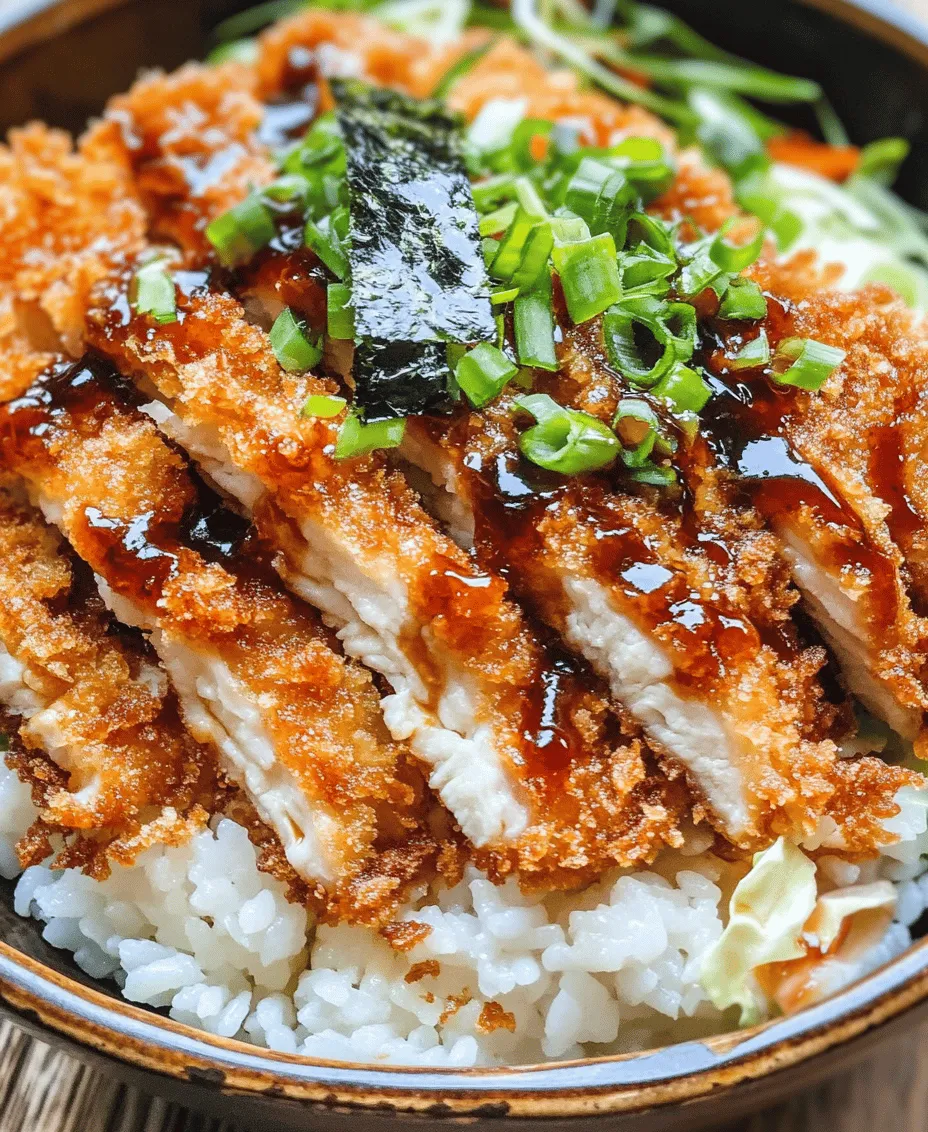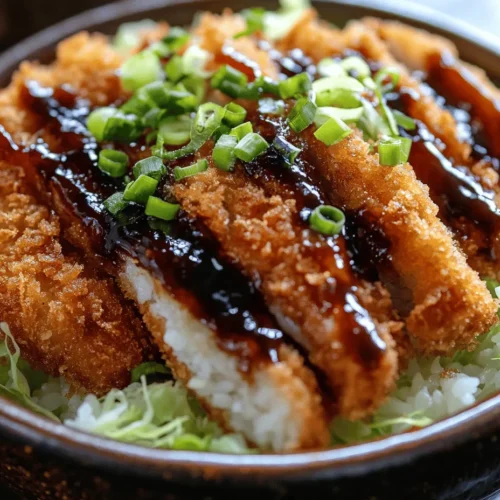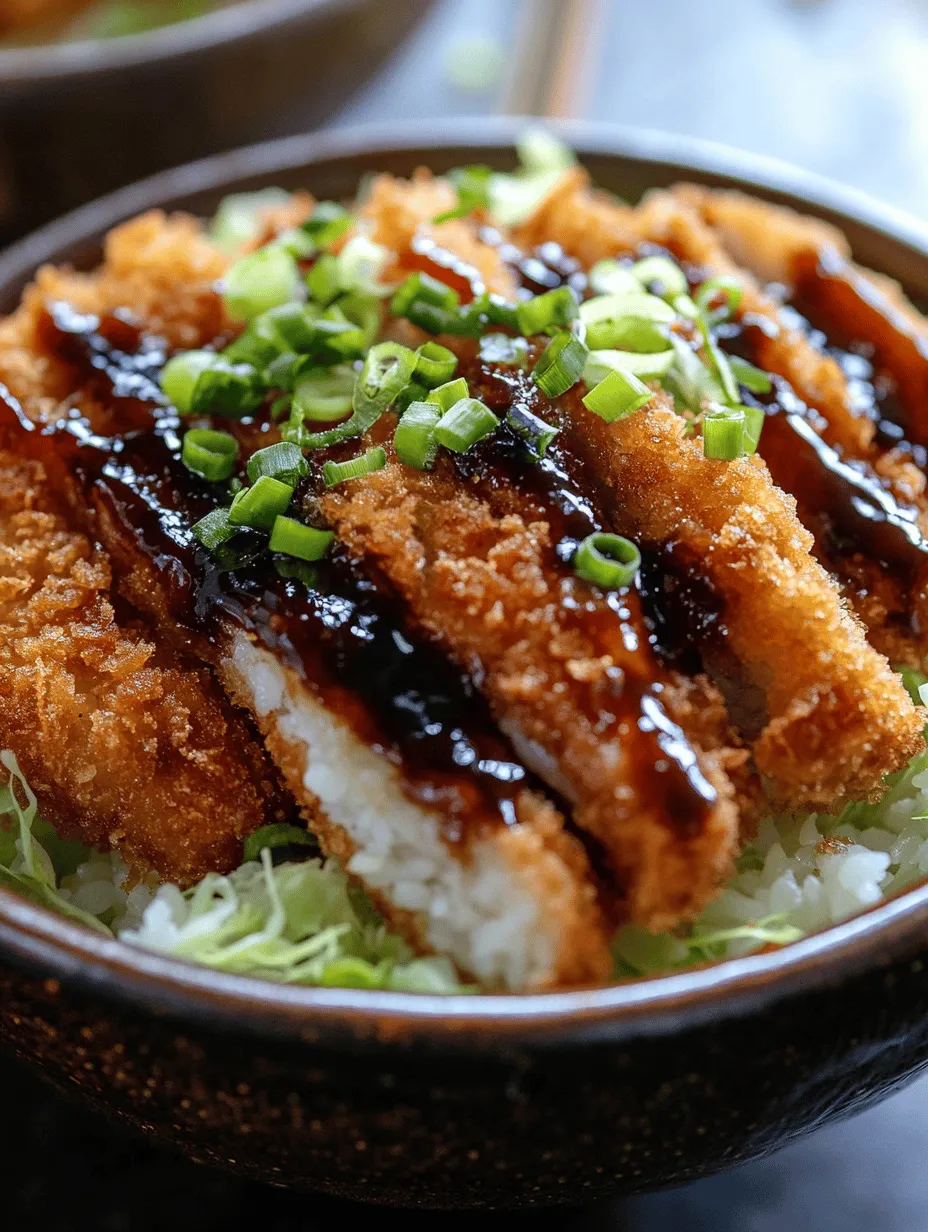Introduction
Katsu, a beloved dish originating from Japan, has captured the hearts and taste buds of food lovers around the globe. This culinary delight, characterized by its crispy, golden-brown coating, typically features meat or vegetables that are breaded and deep-fried to perfection. The cultural significance of Katsu in Japanese cuisine cannot be overstated; it represents comfort food at its finest and is often enjoyed during special occasions and gatherings. Katsu Bowls, in particular, take this iconic dish to another level by serving the crispy cutlets over a bed of rice, creating a comforting and satisfying meal that warms both the palate and the soul.
At the heart of any great Katsu Bowl is the sauce, and that’s where homemade Tonkatsu sauce comes into play. This tangy, savory condiment significantly enhances the flavor of the dish, setting it apart from those made with store-bought alternatives. Making your own Tonkatsu sauce not only ensures authenticity but also allows you to tailor it to your taste preferences, resulting in a dining experience that’s truly your own.
In this article, we will delve into the world of Katsu and Tonkatsu sauce, guiding you through the process of making crispy Katsu Bowls from scratch. You can expect to learn about the history of Katsu, the essential components of Tonkatsu sauce, and detailed techniques for perfecting your Katsu cutlets. By the end of this guide, you’ll have all the tools and knowledge you need to create a delicious, home-cooked Katsu Bowl that rivals your favorite Japanese restaurant.
Understanding Katsu: A Culinary Delight
Definition and History of Katsu
Katsu, short for “katsuretsu,” which means “cutlet” in Japanese, is a dish typically made with meat, most commonly pork or chicken, that has been breaded and deep-fried. Its origins can be traced back to the late 19th century, during the Meiji era, when Western culinary influences began to permeate Japanese dining. The first recorded instance of Katsu was inspired by the European breaded cutlet, which was adapted to suit Japanese tastes.
Today, Katsu can be found in various forms and is a staple in many Japanese households and restaurants. It has become a symbol of comfort food in Japan, frequently served in casual dining settings, making it accessible to all. Over the years, Katsu has evolved, leading to numerous variations, including chicken Katsu, eggplant Katsu, and even shrimp Katsu, each offering its unique twist on this classic dish.
Variations of Katsu in Japanese Cuisine
While pork Katsu remains the most traditional and popular version, other variations have gained prominence, each celebrating different ingredients and flavors. Chicken Katsu is a lighter alternative, made with tender chicken breast, while vegetable Katsu, typically featuring eggplant or zucchini, caters to those seeking a vegetarian option.
In addition to these variations, Katsu has also inspired numerous fusion dishes around the world, such as the Katsu sandwich, which has become a trendy item in cafes and eateries. Each adaptation highlights the versatility of Katsu and its ability to blend seamlessly into various culinary traditions.
The Role of Katsu in Contemporary Global Cuisine
In recent years, Katsu has transcended its cultural boundaries, making its way into global cuisine. Food trucks, pop-ups, and restaurants worldwide are incorporating Katsu into their menus, showcasing the dish’s adaptability and appeal. From Katsu burgers to Katsu tacos, the dish has inspired chefs to innovate and create new flavor experiences, further solidifying its place in contemporary dining.
Katsu’s rise in popularity can be attributed to its satisfying textures and flavors, making it a favorite among food enthusiasts. Its ability to be dressed up or down, served in a bowl, sandwich, or platter, means it can cater to various dining occasions, from casual lunches to elegant dinners.
The Star of the Dish: Tonkatsu Sauce
Explanation of Tonkatsu Sauce and Its Components
Tonkatsu sauce is a key ingredient that elevates Katsu to new heights. This thick, rich sauce boasts a complex flavor profile, combining sweetness, tanginess, and umami. Typically made with a blend of ingredients such as Worcestershire sauce, soy sauce, sugar, and various spices, Tonkatsu sauce adds depth and character to the crispy cutlet.
The beauty of homemade Tonkatsu sauce lies in the ability to control the balance of flavors and adjust the ingredients to suit your personal preferences. While store-bought versions are convenient, they often lack the freshness and customization that comes with homemade preparation.
Importance of Using Homemade Sauce Versus Store-Bought
Using homemade Tonkatsu sauce not only enhances the overall flavor of the dish but also allows you to ensure better quality and freshness. Store-bought sauces may contain preservatives and artificial flavors, detracting from the authentic taste of the dish. By making your own sauce, you can choose high-quality ingredients, ensuring that your Katsu Bowl is as flavorful and satisfying as possible.
In addition, homemade Tonkatsu sauce can be tailored to your specific tastes—whether you prefer it sweeter, spicier, or more savory, the choice is yours. This level of customization is one of the many reasons why making your own sauce is worth the effort.
Healthier Benefits of Making Your Own Sauce
Another advantage of crafting your own Tonkatsu sauce is the potential for a healthier alternative. By using natural ingredients and controlling the amount of sugar and sodium, you can create a sauce that complements your dish without compromising your dietary goals. This is especially important for those who are mindful of their health or have dietary restrictions.
Step-by-Step Guide to Preparing Tonkatsu Sauce
Ingredients Breakdown and Their Roles in Flavor Development
To make Tonkatsu sauce from scratch, you’ll need the following ingredients:
– Worcestershire Sauce: This fermented condiment provides a complex, savory flavor that forms the base of the sauce.
– Soy Sauce: Adds saltiness and depth, enhancing the umami taste.
– Sugar: Balances the savory components with sweetness, creating a well-rounded flavor.
– Ketchup: Contributes sweetness and tanginess, while also thickening the sauce.
– Mirin: A sweet rice wine that adds depth and a hint of sweetness.
– Mustard and Garlic Powder: For a little kick and added flavor complexity.
These ingredients work in harmony to create a rich, flavorful sauce that perfectly complements your Katsu cutlets.
Tips for Customizing the Sauce to Personal Taste Preferences
Feel free to experiment with the ratios of these ingredients based on your personal preferences. For example, if you enjoy a spicier sauce, consider adding a dash of hot sauce or a sprinkle of cayenne pepper. Alternatively, if you prefer a sweeter sauce, increase the sugar or ketchup content.
Perfecting the Katsu: Techniques and Tips
Selection of Pork Chops: What to Look for When Choosing the Right Cut
When it comes to making Katsu, the choice of meat is crucial. For pork Katsu, opt for boneless pork chops or loin, as these cuts offer a perfect balance of tenderness and flavor. Look for meat with a good amount of marbling, which will contribute to the juiciness of the cutlet. Avoid overly lean cuts, as they may end up dry after cooking.
The Significance of Pounding the Meat: How It Affects Texture and Tenderness
One of the essential steps in preparing Katsu is pounding the meat. This technique not only helps to tenderize the pork but also ensures even cooking and a more enjoyable texture. Use a meat mallet or rolling pin to gently pound the pork chops to an even thickness, about ½ inch. This will allow the meat to cook uniformly, resulting in a tender, juicy cutlet that is perfectly crispy on the outside.
Seasoning: Importance of Salt and Pepper in Enhancing Flavor
Before breading your pork cutlets, be sure to season them generously with salt and pepper. This step is crucial for enhancing the flavor of the meat itself, ensuring that every bite is delicious. Allow the seasoned pork to rest for a few minutes to absorb the flavors before moving on to the breading process.
The Breading Process: Explanation of the Three-Step Breading Station
The breading process is where the magic happens, transforming simple pork cutlets into crispy Katsu. To achieve the perfect breading, set up a three-step breading station:
1. Flour: Dredge the seasoned pork cutlet in all-purpose flour, shaking off any excess. This step helps the egg adhere to the meat.
2. Egg Wash: Dip the floured cutlet into a beaten egg, ensuring it is fully coated. The egg acts as a binder, allowing the breadcrumbs to stick effectively.
3. Panko Breadcrumbs: Finally, coat the cutlet with panko breadcrumbs, pressing gently to ensure an even layer. Panko, a Japanese-style breadcrumb, provides a lighter, crunchier texture compared to traditional breadcrumbs, resulting in that signature crispy exterior.
By following these steps carefully, you can ensure that your Katsu cutlets are perfectly crispy and full of flavor, setting the stage for a delicious Katsu Bowl.
In the next part of this guide, we will explore the frying process, tips for achieving the ideal crispy texture, and finally assembling your Katsu Bowls with all the delicious elements you’ve prepared. Stay tuned for more insights into creating the ultimate Crispy Katsu Bowls with Homemade Tonkatsu Sauce.

Tips for Achieving the Perfect Panko Crust
Creating that signature crispy texture is essential for a delicious Katsu Bowl, and using panko breadcrumbs is the key to achieving this. Here are some tips to ensure your panko crust comes out perfectly every time:
1. Use Fresh Panko: Always opt for fresh panko breadcrumbs. Stale breadcrumbs won’t crisp up as well. If you’re unsure about the freshness, toast them lightly in a dry pan before using them to enhance their texture.
2. Double Breading: For an extra-crispy crust, consider double breading your Katsu. After the first dip in flour and egg, add another layer of panko. This extra step can make a significant difference in texture.
3. Season Your Panko: Enhance the flavor of your Katsu by seasoning the panko breadcrumbs with salt, pepper, or even spices like garlic powder or paprika. This adds depth to the crust without overwhelming the dish.
Common Pitfalls to Avoid During Breading
When breading your Katsu, there are a few common mistakes to watch out for:
1. Wet Ingredients on the Bread Crumbs: Ensure that your chicken is adequately coated with flour and egg before adding the panko. Excess moisture can make the breadcrumbs soggy, preventing them from achieving that coveted crispiness.
2. Not Pressing Down: When coating the chicken with panko, press down firmly. This ensures the breadcrumbs adhere well and forms a thicker crust that can withstand frying.
3. Overcrowding the Frying Pan: If you’re frying multiple pieces at once, avoid overcrowding the pan. This can lower the oil temperature and lead to soggy katsu instead of crispy delights.
Frying the Katsu: Achieving Crispiness
Ideal Oil Selection for Frying: Why Vegetable Oil Works Best
When it comes to frying Katsu, your choice of oil matters. Vegetable oil is an excellent option due to its high smoke point and neutral flavor. This allows the Katsu to fry evenly without imparting any unwanted flavors. Other suitable oils include canola oil and sunflower oil, which also have high smoke points and are widely available.
Tips for Maintaining the Right Frying Temperature
Maintaining the proper frying temperature is crucial for achieving that crispy exterior. Here’s how to do it effectively:
– Preheat the Oil: Before adding the chicken, heat your oil to about 350°F (175°C). Use a thermometer to ensure accuracy.
– Fry in Batches: If you’re cooking multiple pieces, fry them in batches rather than all at once. This helps maintain the temperature of the oil and ensures even cooking.
– Adjust Heat as Needed: Keep an eye on the oil temperature. If it begins to smoke, it’s too hot; lower the heat. Conversely, if the Katsu isn’t browning, increase the heat slightly.
How to Tell When the Katsu is Perfectly Cooked
The perfect Katsu should be golden brown and crispy. To check for doneness:
– Visual Cues: Look for a deep golden color on the crust. It should not be pale, which indicates undercooking.
– Internal Temperature: Use a meat thermometer to test for doneness. Chicken should reach an internal temperature of 165°F (75°C).
Draining Excess Oil: Techniques for Retaining Crispiness
Properly draining excess oil is vital for keeping the Katsu crispy. Here are a few techniques to consider:
– Use a Wire Rack: After frying, place the Katsu on a wire rack instead of paper towels. This allows air circulation around the chicken, preventing sogginess.
– Avoid Stacking: Do not stack the fried Katsu on top of each other, as this can trap steam and moisture, ruining the crispy texture.
Building the Katsu Bowl: A Layered Approach
The Significance of Rice as a Base: Types of Rice to Consider
Rice is a fundamental component of a Katsu Bowl, providing a hearty base for the dish. Here are two popular options:
– White Rice: The most common choice, white rice is fluffy and has a neutral flavor that complements the Katsu and sauce.
– Brown Rice: For a healthier alternative, brown rice offers more fiber and nutrients. It has a nuttier flavor and chewier texture, which can add an interesting contrast to the Katsu.
Importance of Garnishes: How Shredded Cabbage, Green Onions, Pickled Ginger, and Nori Elevate the Dish
Garnishes play a significant role in enhancing both the flavor and the visual appeal of your Katsu Bowl:
– Shredded Cabbage: Adds a refreshing crunch and balances the richness of the fried Katsu. It can also absorb some of the sauce, making each bite more flavorful.
– Green Onions: A sprinkle of finely chopped green onions adds a pop of color and a mild onion flavor that brightens the dish.
– Pickled Ginger: This tangy condiment cuts through the richness of the Katsu and adds a delightful zing.
– Nori: Shredded nori or seaweed adds a savory umami flavor, tying in the Japanese element of the dish.
Step-by-Step Instructions for Assembling the Katsu Bowl
1. Prepare the Rice: Cook your choice of rice according to the package instructions. Fluff and let it sit for a few minutes.
2. Layer the Rice: Spoon a generous portion of rice into a bowl, creating a bed for the Katsu.
3. Add the Katsu: Place the crispy Katsu on top of the rice. Cut it into strips for easy eating and to showcase the beautiful crust.
4. Garnish: Top the Katsu with shredded cabbage, green onions, and pickled ginger. For an extra touch, sprinkle some nori on top.
5. Drizzle with Tonkatsu Sauce: Finally, drizzle the homemade Tonkatsu sauce over the Katsu and the rice. Serve immediately for the best experience.
Presentation Tips for a Visually Appealing Dish
– Use Colorful Ingredients: Incorporate a variety of colors in your garnishes to make the dish visually appealing.
– Layer Thoughtfully: Arrange the garnishes in a way that looks artful rather than haphazard. Consider the height and balance of the components.
– Choose the Right Bowl: A deep, wide bowl offers an inviting presentation and allows for layering, making the dish look more gourmet.
Nutritional Insights: Understanding the Katsu Bowl
Breakdown of the Nutritional Value of the Katsu Bowl Ingredients
Understanding the nutritional content of your Katsu Bowl can help you make informed choices:
– Protein: Chicken provides a good source of protein, essential for muscle repair and overall health.
– Carbohydrates: Rice is a primary source of carbohydrates, providing energy to fuel your day.
– Vitamins and Minerals: Garnishes like cabbage and green onions contribute vitamins A and C, while pickled ginger aids digestion.
Discussion on Portion Sizes and Balance of Flavors
When serving Katsu Bowls, consider the following for balanced meals:
– Portion Control: Aim for a balanced ratio of protein, carbs, and vegetables. A serving of Katsu should be about the size of your palm, with equal amounts of rice and garnishes.
– Flavor Balance: Ensure that the flavors are harmonious. The richness of the Katsu should be balanced by the freshness of the cabbage and the tanginess of the sauce.
Benefits of Homemade Meals Versus Takeout Options
Homemade Katsu Bowls offer several advantages over takeout:
– Control Over Ingredients: You can choose high-quality ingredients and adjust the recipe to suit dietary needs or preferences.
– Cost-Effective: Preparing Katsu Bowls at home is often more economical than ordering from a restaurant, especially when feeding a family.
– Satisfaction of Cooking: There’s a sense of accomplishment and joy that comes from cooking a meal from scratch, enhancing your dining experience.
Cultural Context: Katsu Bowls in Japanese Dining
Overview of How Katsu Bowls are Enjoyed in Japan and Globally
Katsu Bowls, particularly Tonkatsu, are beloved in Japan and have gained popularity worldwide. In Japan, they are often served as a comforting home-cooked meal or enjoyed in restaurants. The dish embodies the essence of “kaizen,” or continuous improvement, with each cook putting their personal touch on the recipe.
The Social Aspect of Sharing Meals and Family Dining
In Japanese culture, meals are often a communal experience. Sharing a Katsu Bowl with family or friends fosters connection and warmth, making it more than just about the food—it’s about the experience of dining together.
Exploration of Variations in Katsu Bowls Across Different Cultures
While the traditional Katsu Bowl features chicken or pork, variations exist worldwide. In other countries, you might find Katsu made with different proteins, such as shrimp or tofu, and served with local twists—like spicy sauces or additional toppings.
Conclusion
In summary, creating a crispy Katsu Bowl with homemade Tonkatsu sauce involves attention to detail at every stage of the cooking process. From perfecting the panko crust to artfully assembling the bowl, each component contributes to the overall enjoyment of the dish. Don’t hesitate to experiment with flavors and customize your Katsu Bowl to your liking. Cooking at home not only allows for creativity but also offers a rewarding experience that brings people together. Embrace the joy of cooking and savor the delicious results of your efforts.



